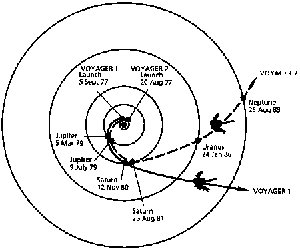Happy Anniversary Voyager!
News story originally written on August 22, 1997
The Voyager program is celebrating its 20th anniversary. Voyager 1 and Voyager 2 were both launched in the summer of 1977 from Cape Canaveral. Their main mission was to explore Jupiter and its moons, Saturn and its rings, Neptune, and Uranus.
The Voyager spacecraft were originally designed to have a lifetime of 5 years. The two spacecraft operated so smoothly that the mission was extended. In fact, Voyager 1 and Voyager 2 are still operating even after 20 years of travelling outward through the solar system.
This extended mission means that the spacecraft are continuing to explore the outer solar system environments. Scientists are hoping that the spacecraft will reach the heliopause boundary, the limit of the Sun's influence. This would truly be where no spacecraft has gone before! Penetration of the heliopause boundary between the solar wind and the interstellar medium will allow measurements to be made of the interstellar fields, particles and waves unaffected by the solar wind. The Voyager spacecraft are expected to near the heliopause by 2002. Barring any serious system failures, it is expected that the two spacecraft will survive another 20 years at which time their power sources will run out.
An interesting bit of trivia from the overall Voyager mission is that a total of 11,000 workyears have been put into the program through the Neptune encounter. This is only one-third the amount of effort estimated to complete the great pyramid at Giza to King Cheops.















